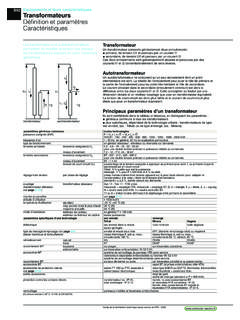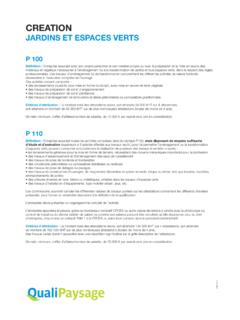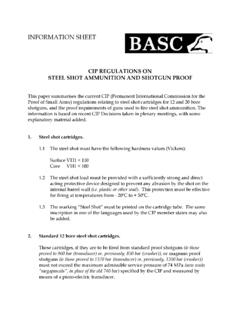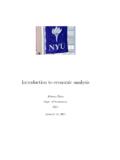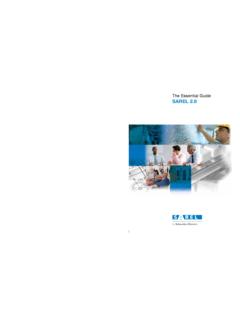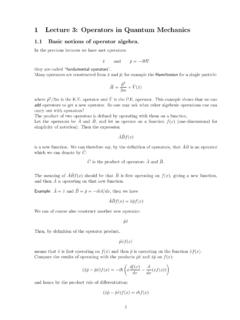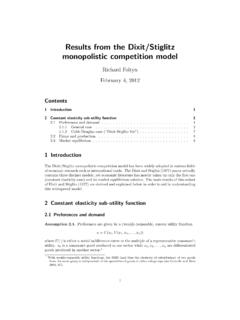Transcription of The De˚nition and Classi˚cation of Dry Eye Disease
1 DEWS Definition and Classification The Definition and Classification of Dry Eye Disease : Report of the Definition and Classification Subcommittee of the International Dry E y e W ork Shop (2 0 0 7 ). ABSTRACT The aim of the DEWS Definition and Classifica- I. INTRODUCTION. he Definition and Classification Subcommittee T. tion Subcommittee was to provide a contemporary definition of dry eye Disease , supported within a comprehensive clas- reviewed previous definitions and classification sification framework. A new definition of dry eye was devel- schemes for dry eye, as well as the current clinical oped to reflect current understanding of the Disease , and the and basic science literature that has increased and clarified committee recommended a three-part classification system. knowledge of the factors that characteriz e and contribute to The first part is etiopathogenic and illustrates the multiple dry eye.
2 Based on its findings, the Subcommittee presents causes of dry eye. The second is mechanistic and shows how herein an updated definition of dry eye and classifications each cause of dry eye may act through a common pathway. based on etiology, mechanisms, and severity of Disease . It is stressed that any form of dry eye can interact with and exacerbate other forms of dry eye, as part of a vicious circle. II. GOALS OF THE DEFINITION AND. Finally, a scheme is presented, based on the severity of the CLASSIFICATION SUBCOMMITTEE. dry eye Disease , which is expected to provide a rational basis The goals of the DEWS Definition and Classification for therapy. These guidelines are not intended to override the Subcommittee were to develop a contemporary definition of clinical assessment and judgment of an expert clinician in dry eye Disease and to develop a three-part classification of individual cases, but they should prove helpful in the conduct dry eye, based on etiology, mechanisms, and Disease stage.
3 Of clinical practice and research. The manner of working of the committee is outlined in the introduction to this issue of The O cular S urface. Further KEYWORDS definition, DEWS, dry eye Disease , Dry Eye details are published on the TFOS-DEWS web-site (www. WorkShop, etiopathogenesis, mechanism, severity grading ). III. DEFINITION OF DRY EYE Disease . The committee reviewed the definition and classifica- tion presented at the 19 9 5 National Eye Institute (N E I)/In- dustry Dry Eye Workshop, which was: Dry eye is a disorder Accepted for publication January 2007. of the tear film due to tear deficiency or excessive evaporation, which causes damage to the interpalpebral ocular surface and Definition and Classfication Subcommittee members: M ic hae l A . L e m p , M D. (Chair); Christophe Baudouin, MD, PhD; Jules Baum, MD; Murat Dogru, is associated with symptoms of ocular MD; Gary N. Foulks, MD; Shigeru Kinoshita, MD; Peter Laibson, MD; James The committee agreed that the definition could be McCulley, MD; Juan Murube, MD, PhD; Stephen C.
4 Pflugfelder, MD; Mauriz io improved in the light of new knowledge about the roles of Rolando, MD; Ikuko Toda, MD. tear hyperosmolarity and ocular surface inflammation in The Subcommittee is indebted to Professors Bron and Foulks for their invaluable contributions to the writing of this report. dry eye and the effects of dry eye on visual function. Initially Proprietary interests of Subcommittee members are disclosed on pages 202. two definitions were developed and presented to members and 204. of the workshop. These general and operational defini- Reprints are not available. Articles can be accessed at: tions overlapped to some ex tent, and, therefore, in this final Correspondence in regard to the this chapter should be addressed to Michael report, these versions have been combined to produce the A. Lemp, MD, 4000 Cathedral Avenue NW, Apt 828B, Washington, DC 20016 following definition: (Email: Tel: 202-338-6424) Dry eye is a multifactorial Disease of the tears and ocu- lar surface that results in symptoms of discomfort,2-4.
5 2007 Ethis Communications, Inc. The Ocular Surface ISSN: 1542- visual disturbance,5-7 and tear film instability8-10 with 0124. (No authors listed ). T he d efi nition and classifi cation of d ry eye potential damage to the ocular surface. It is accompa- d isease: report of the Defi nition and Classifi cation Sub committee of the International Dry Eye W orkShop (2007). 2007;5(2):75-92. nied by increased osmolarity of the tear film11-14 and inflammation of the ocular ,16. THE OCULAR SURF ACE / APRIL 2007, VOL. 5, NO. 2 / 75. DEWS DEFINITION AND CLASSIFICATION. OUTLINE. film, the transparency of the cornea, and the quality of the image projected onto the At the 2007 Dry Eye I. Introduction WorkShop, it was noted that the corneal and conjunctival II. Goals of the Definition and Classification epithelia are in continuity, through ductal epithelia, with Subcommittee the acinar epithelia of the main and accessory lacrimal III.
6 Definition of dry eye Disease glands and the meibomian glands, which themselves arise IV . Classification of dry eye Disease as specialized invaginations from the ocular surface. Also, A. Background these epithelia have the same embryological derivation. This B. Etiopathogenic classification of dry eye Disease broader concept, which has additional features, has been 1. Aqueous tear-deficient dry eye termed the Ocular Surface System and is discussed further a. Sjogren syndrome dry eye in the Research chapter of this b. Non-Sjogren syndrome dry eye An important aspect of the unit is the part played by 1) Primary lacrimal gland deficiencies sensory impulses, which arise from the ocular surface, in the 2) Secondary lacrimal gland deficiencies maintenance of resting tear flow. Currently, it is considered that waking tear flow is a reflex response to afferent im- 3) Obstruction of the lacrimal gland ducts pulses deriving particularly, but not entirely, from the ocular 4) Reflex hyposecretion Sensory input from the nasal mucosa also makes a) Reflex sensory block a Disease or damage to any component of b) Reflex motor block the LFU (the afferent sensory nerves, the efferent autonomic 2.
7 Evaporative dry eye and motor nerves, and the tear-secreting glands) can desta- a. Intrinsic causes bilize the tear film and lead to ocular surface Disease that 1) Meibomian gland dysfunction expresses itself as dry eye. Tear film stability, a hallmark of 2) Disorders of lid aperature and lid/globe the normal eye, is threatened when the interactions between congruity or dynamics stabilizing tear film constituents are compromised by de- 3) Low blink rate creased tear secretion, delayed clearance, and altered tear b. Extrinsic causes composition. Ocular surface inflammation is a secondary 1) Ocular surface disorders consequence. Reflex tear secretion in response to ocular 2) Contact lens wear irritation is envisioned as the initial compensatory mecha- 3) Ocular surface Disease nism, but, with time, inflammation accompanying chronic 4) Allergic conjunctivitis secretory dysfunction and a decrease in corneal sensation eventually compromises the reflex response and results in C.
8 The causative mechanisms of dry eye even greater tear film instability. Perturbation of the LFU. 1. Tear hyperosmolarity is considered to play an important role in the evolution of 2. Tear film instability different forms of dry eye. D. The basis for symptoms in dry eye The distinctions aq ueous-deficient dry eye and evaporative E. Classification of dry eye based on severity dry eye were removed from the definition, but are retained in the etiopathogenic classification. Dry eye is recognized as a disturbance of the Lacrimal IV. CLASSIFICATION OF DRY EYE Disease . F unctional U nit (LFU), an integrated system comprising A. Background the lacrimal glands, ocular surface (cornea, conjunctiva V itali, writing about the harmonized classification crite- and meibomian glands) and lids, and the sensory and mo- ria for Sjogren syndrome (SS) remarked that classification tor nerves that connect Trigeminal sensory fibers criteria are not necessarily appropriate for use in diagnosis arising from the ocular surface run to the superior salivary and may lead to misclassification of a Disease , particularly nucleus in the pons, from whence efferent fibers pass, in the in its early In an individual patient, a classification nervus intermedius, to the pterygopalatine ganglion.
9 Here, scheme can provide a guide, but an expert clinician, apply- postganglionic fibers arise, which terminate in the lacrimal ing appropriate diagnostic criteria, is needed to establish gland, nasopharynx, and vessels of the orbit. Another neural a diagnosis. pathway controls the blink reflex, via trigeminal afferents Although the NEI/Industry Workshop classification1 has and the somatic efferent fibers of the seventh cranial nerve. served as a useful and durable scheme for over a decade, it Higher centers feed into the brainstem nuclei, and there is does not reflect newer knowledge on pathophysiological a rich sympathetic supply to the epithelia and vasculature mechanisms, effects on vision, and the utility of an assess- of the glands and ocular surface. ment of severity of Disease . Recently, two new classification This functional unit controls the major components schemes were published, and these were used as source of the tear film in a regulated fashion and responds to documents by the committee.
10 These include: the Triple environmental, endocrinological, and cortical influences. Classification25,26 and the report of the Delphi Its overall function is to preserve the integrity of the tear The Triple Classification evolved from reports presented 76 THE OCULAR SURFACE / APRIL 2007, VOL. 5, NO. 2 / DEWS DEFINITION AND CLASSIFICATION. DRY EYE. Eff ect of the Environment Milieu Interieur Aqueous-deficient Evaporative Low blink rate behavior, VTU, microscopy Wide lid aperture gaze position Sjogren Aging Syndrome Intrinsic Extrinsic Low androgen pool Systemic Drugs: Dry Eye antihistamines, beta-blockers, Primary Non-Sjogren Meibomian Oil Vitamin A- antispasmodics, Deficiency Deficiency diuretics, and Dry Eye some psychotropic Secondary drugs Lacrimal Disorders Topical Drugs Deficiency of Lid Preservatives Milieu Exterieur Aperture Low relative humidity High wind velocity Lacrimal Contact Lens Occupational Gland Duct Low Blink Wear environment Obstruction Rate Ocular Surface Reflex Block Drug action Disease Accutane eg, Allergy Systemic Drugs Figure 1.




